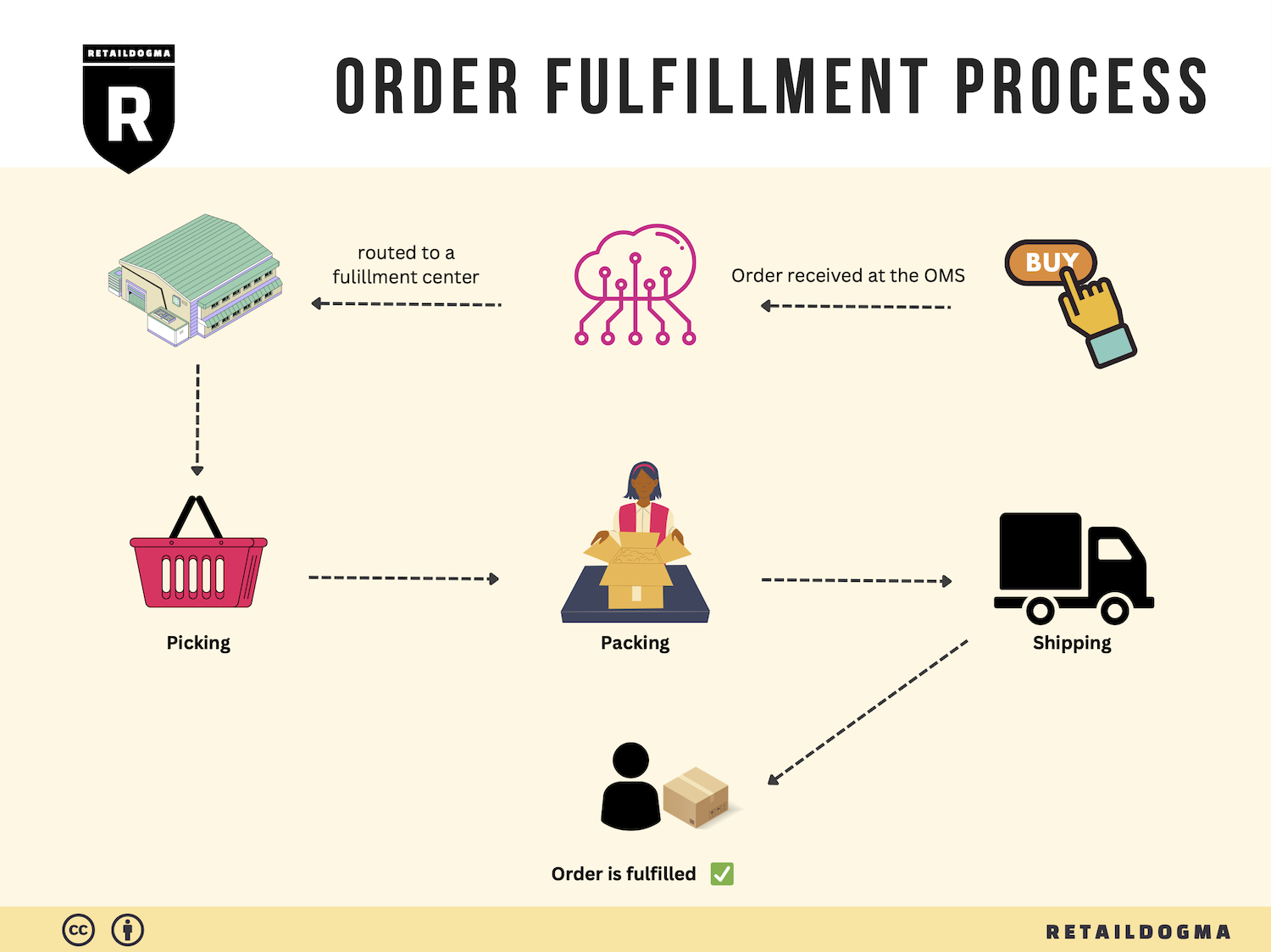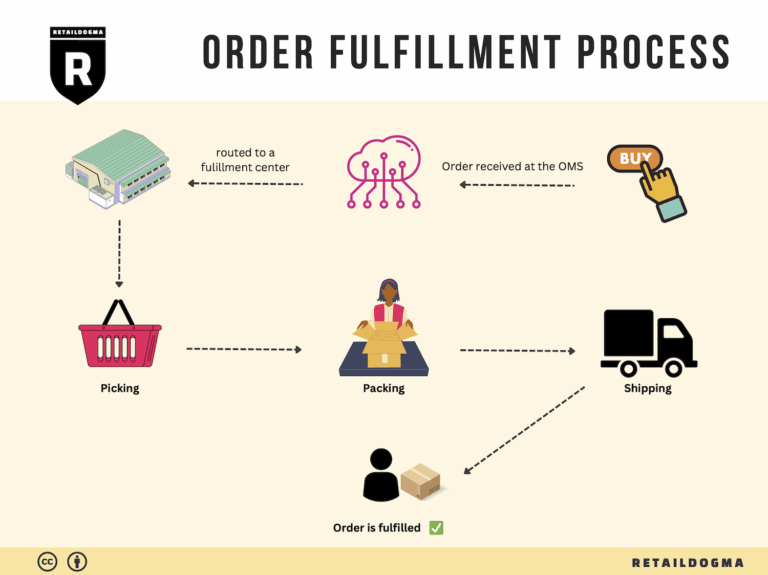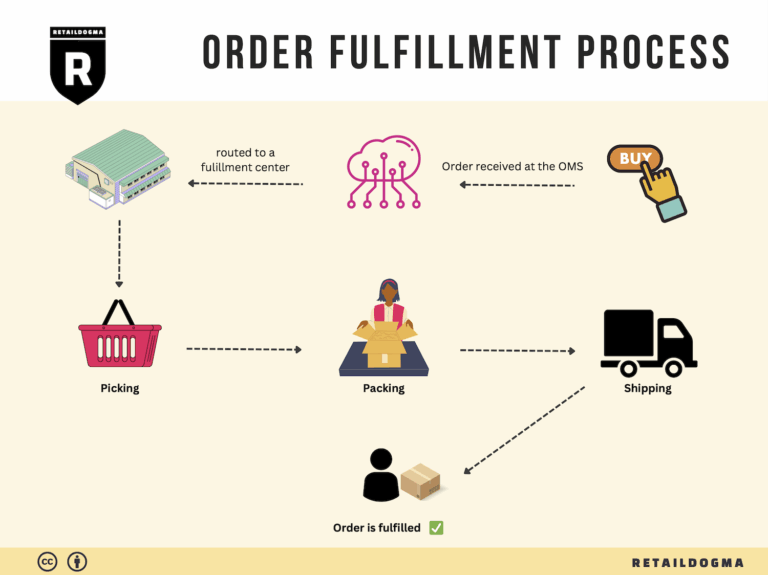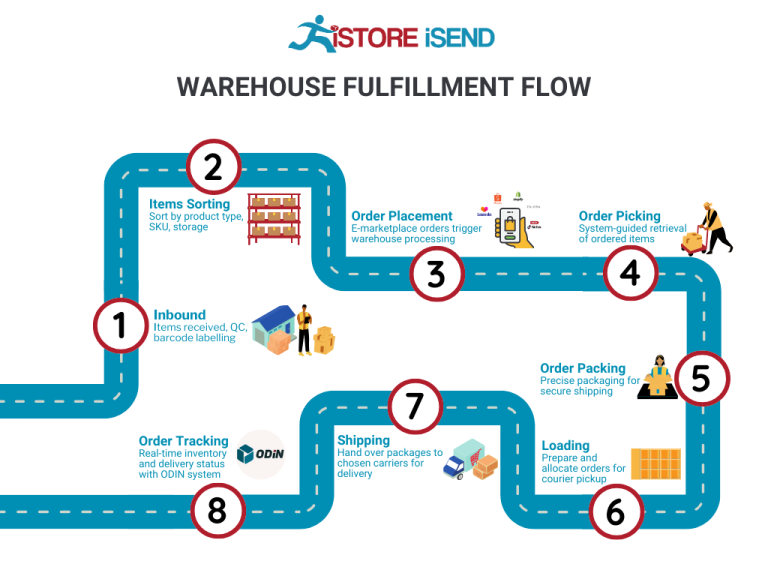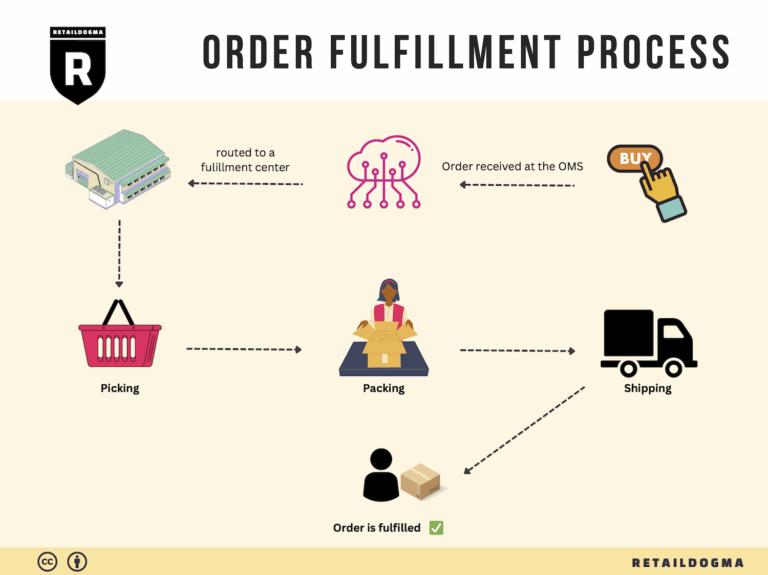How Order Fulfillment Works: A Step-by-Step Guide for Businesses
What is E-commerce Fulfillment? An Introduction for Growing Businesses
Understanding E-commerce Fulfillment: A Vital Component for Growth
As an e-commerce business owner, you’re likely familiar with the daunting challenges of managing orders, packing products, and shipping them out to customers. With every order, the complexity increases, and what once felt manageable can quickly become overwhelming. This is where e-commerce fulfillment comes into play, serving as a crucial backbone to your operations. In its simplest form, fulfillment is the process of getting a product into the hands of your customers—from storage and packing to shipping and handling returns.
For growing businesses, effective fulfillment is not just about logistics; it’s about creating a seamless customer experience that can drive repeat sales and build brand loyalty. As you scale, the demands on your fulfillment processes will evolve. This guide will help you navigate these changes by providing a comprehensive overview of e-commerce fulfillment options tailored to your unique needs.
We will explore various fulfillment models, including third-party logistics (3PL) and Fulfillment by Amazon (FBA), each offering distinct advantages based on your business size and product type. Understanding these models will empower you to select the right approach for your operations.
In addition to models, we will delve into the core services offered by fulfillment providers. These include inventory management, order processing, kitting, and reverse logistics—services that can significantly enhance your efficiency and customer satisfaction.
Choosing the right fulfillment partner is critical to your success. We’ll provide practical insights on what to look for in a provider, including their technology capabilities, pricing structures, and accuracy rates. By asking the right questions and evaluating potential partners against your business goals, you can find a solution that not only meets your current needs but also scales with you as you grow.
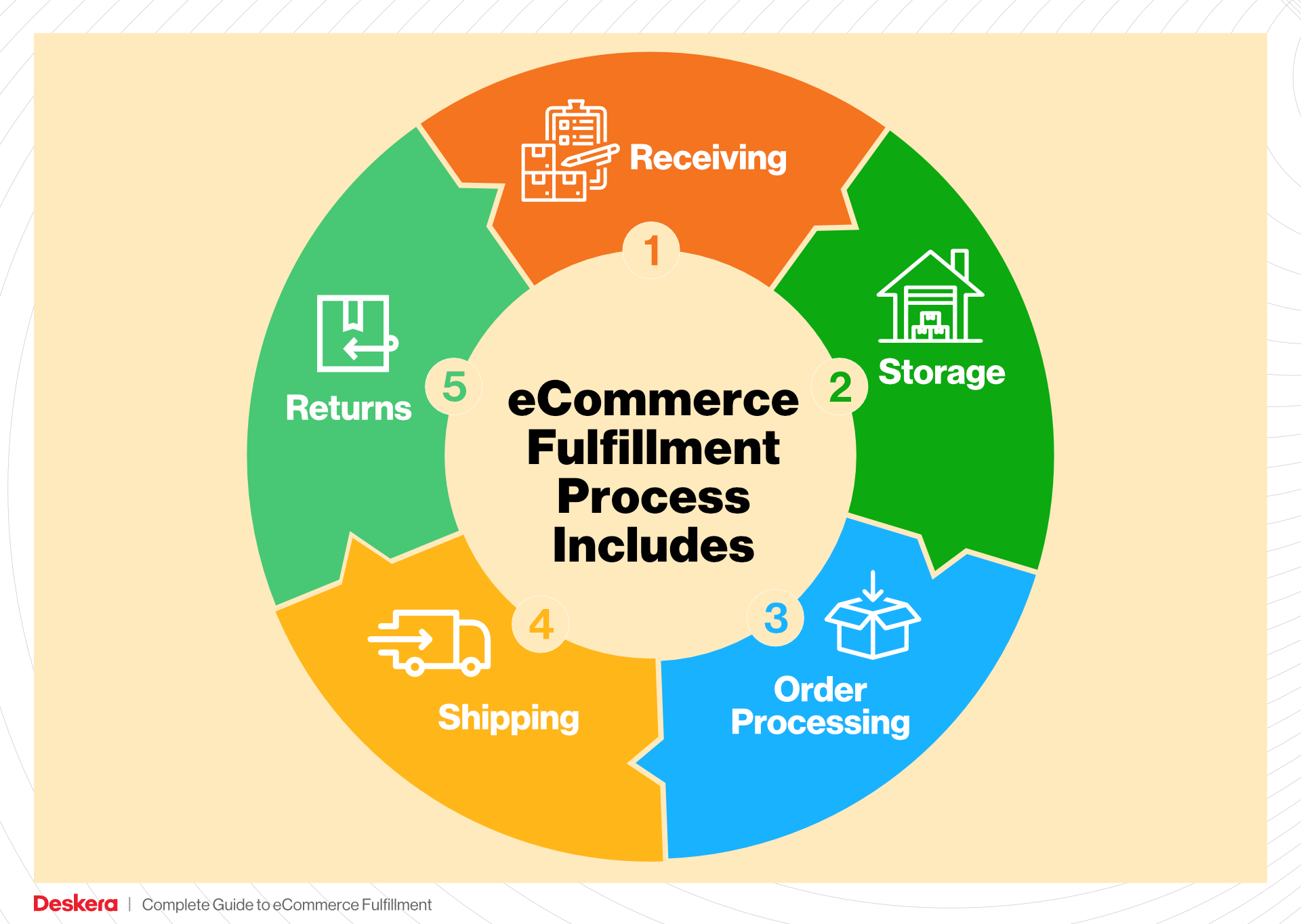
Finally, we’ll discuss pricing—an essential consideration when selecting a fulfillment partner. Understanding the cost structure of various fulfillment services will allow you to make informed decisions that align with your budget and operational goals.
The ultimate goal of this guide is to empower you with the knowledge and tools necessary to make smart logistics decisions. By understanding the intricacies of e-commerce fulfillment, you can focus more on what you do best: growing your business and delighting your customers.
What You’ll Learn In This Guide
- What is E-commerce Fulfillment? An Introduction for Growing Businesses
- The Order Fulfillment Process: From ‘Buy’ Button to Customer’s Door
- Comparing Fulfillment Models: In-House vs. 3PL vs. Dropshipping
- A Deep Dive into Amazon FBA: Pros, Cons, and Who It’s For
- Core Services Offered by Fulfillment Centers
- How to Choose a Fulfillment Partner: A 6-Point Checklist
- Understanding Fulfillment Pricing: A Breakdown of Common Fees
- Frequently Asked Questions (FAQs) about Fulfillment
- Conclusion: Is Outsourcing Fulfillment the Right Move for Your Business?
- Important Disclaimer
The Order Fulfillment Process: From ‘Buy’ Button to Customer’s Door
1. Receiving Inventory
The first step in the order fulfillment process is receiving inventory from suppliers. This involves checking incoming shipments against purchase orders to ensure that the right products, quantities, and conditions are met. When products arrive at the warehouse, they are inspected for damage and accuracy, then logged into the inventory management system.
Importance: This step is crucial because it sets the foundation for effective inventory management. Inaccurate receiving can lead to stock discrepancies, which can affect order fulfillment and customer satisfaction.
Key Term: SKU (Stock Keeping Unit) – A unique identifier assigned to each product, which helps track inventory levels and facilitates efficient management of stock.
2. Warehouse Storage
Once the inventory is received and logged, it is then stored in designated areas within the warehouse. Proper organization is essential; products should be stored based on their size, type, and demand frequency. This could involve using racks, shelves, or bins to optimize space and accessibility.
Importance: Efficient warehouse storage minimizes retrieval time and maximizes the use of space. By strategically placing high-demand items closer to packing stations, businesses can enhance their operational efficiency, ultimately leading to faster order processing.
Key Term: ABC Analysis – A method of inventory categorization where items are divided into three categories (A, B, and C) based on their importance and sales volume. “A” items are high-value and low-quantity, while “C” items are low-value and high-quantity.
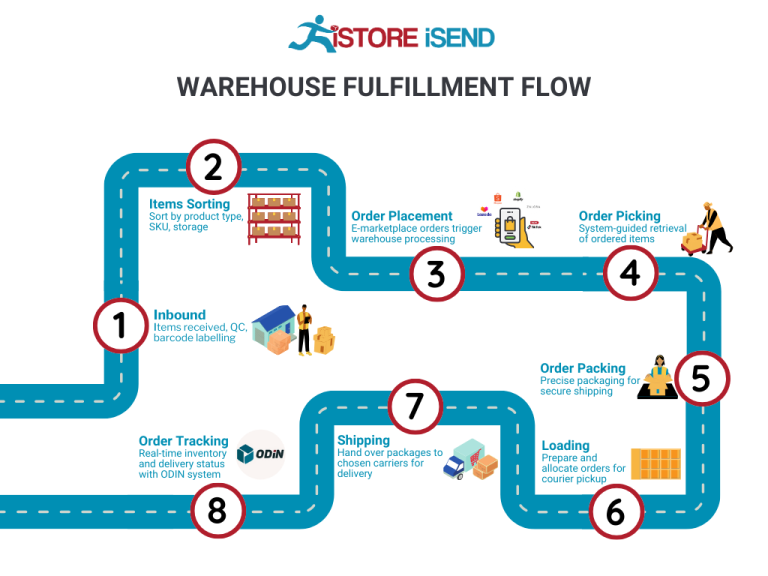
3. Order Picking
When a customer places an order, the next step is order picking. This process involves retrieving the items from their storage locations based on a pick list generated by the order management system. Employees, often referred to as pickers, follow this list to gather the correct items for each order.
Importance: Accurate order picking is vital to ensure that customers receive the correct products, directly impacting customer satisfaction and reducing return rates. Efficient picking processes can also significantly reduce the time it takes to fulfill an order.
Key Term: Pick Lists – Documents that outline the specific items and quantities to be retrieved for each order, serving as a guide for pickers to ensure accuracy and efficiency during the picking process.
4. Order Packing
After the items are picked, they are brought to the packing station, where they are prepared for shipment. This involves checking the items again for accuracy, packing them securely in appropriate boxes, and labeling them with shipping information. Some businesses may also include packing slips or promotional materials in the packages.
Importance: Proper packing is essential to prevent damage during transit and to provide a positive unboxing experience for the customer. It’s also a chance to reinforce brand identity through customized packaging.
Key Term: Packing Slip – A document included with the shipment that lists the items contained in the package, allowing customers to verify that they received the correct order.
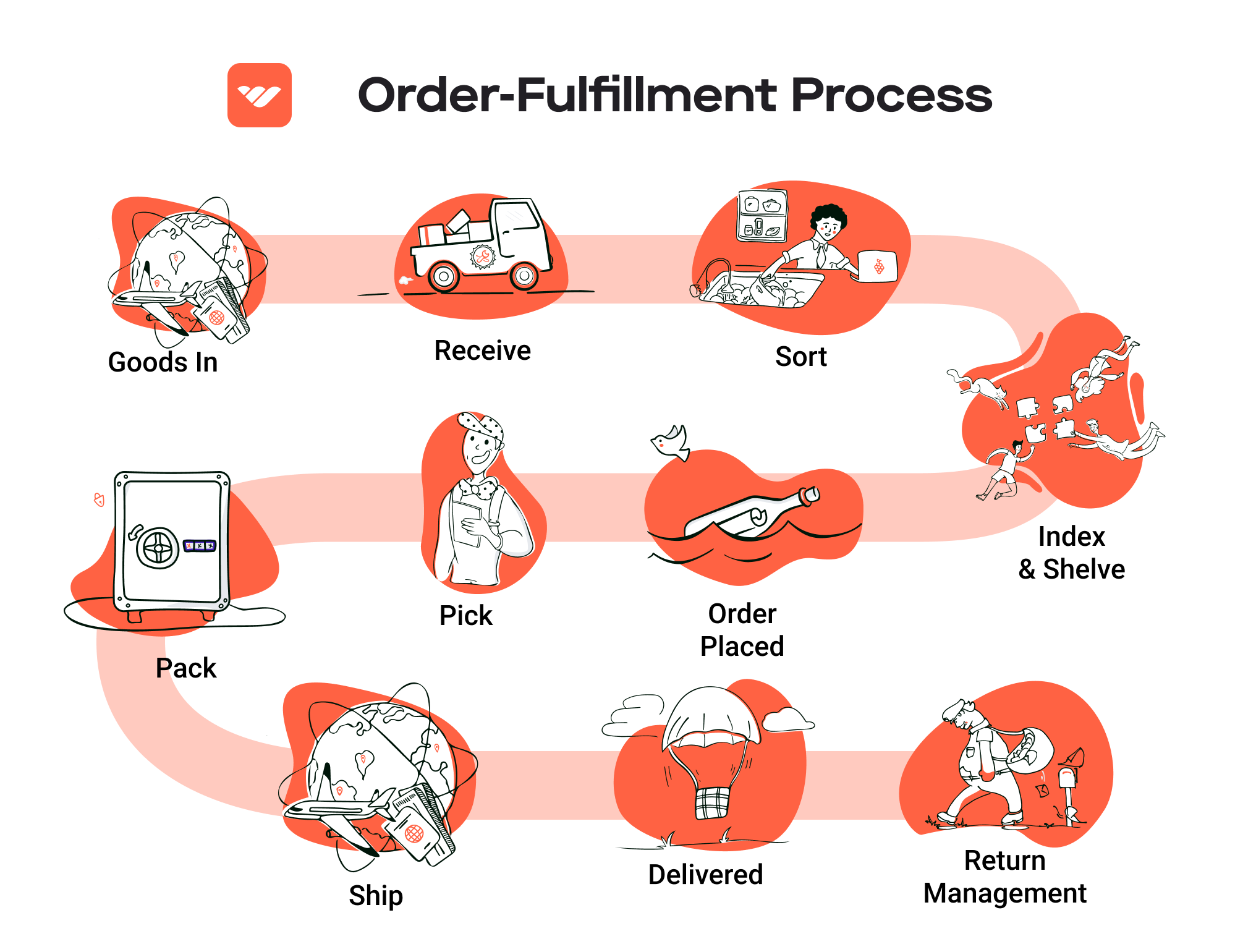
5. Shipping & Delivery
The final step in the fulfillment process is shipping the packed orders to the customer. This involves selecting appropriate shipping carriers based on cost, speed, and reliability. Once the orders are shipped, tracking information is generated and communicated to the customer.
Importance: Timely shipping and delivery are critical factors in customer satisfaction and retention. Efficient shipping processes can help businesses maintain competitive advantage, especially in a market where consumers expect fast delivery.
Key Term: Last Mile Delivery – The final step of the delivery process where the product reaches the customer’s doorstep. This segment is often the most complex and costly part of logistics, making it crucial for fulfillment success.
In summary, each step of the order fulfillment process plays a vital role in delivering a seamless customer experience. By understanding and optimizing these steps, e-commerce businesses can enhance efficiency, reduce costs, and ultimately improve customer satisfaction.
Comparing Fulfillment Models: In-House vs. 3PL vs. Dropshipping
Fulfillment Model Comparison
| Model | Who Handles Inventory | Best For (Business Stage) | Key Advantage | Key Disadvantage |
|---|---|---|---|---|
| In-House Fulfillment | Your own team | Established businesses | Full control over processes | High overhead costs and resource demands |
| Third-Party Logistics (3PL) | External fulfillment partner | Growing and scaling businesses | Cost-effective and scalable solutions | Less control over fulfillment processes |
| Dropshipping | Supplier or manufacturer | Startups and small businesses | Low upfront investment | Lower margins and potential stock issues |
In-House Fulfillment
In-house fulfillment refers to managing the entire inventory and shipping process within your own organization. This model is typically favored by established businesses that have the resources to handle warehousing, order processing, and shipping internally. One of the primary advantages of in-house fulfillment is the complete control it provides over the entire logistics process, from inventory management to customer service. Businesses can tailor their processes to meet specific customer needs, ensuring a personalized experience that can enhance customer satisfaction.
However, this model comes with significant drawbacks. The overhead costs associated with maintaining a warehouse, hiring staff, and investing in technology can be substantial. Additionally, as order volumes grow, the complexity of managing fulfillment in-house can become overwhelming. Companies may find themselves stretched thin, diverting focus from core business activities such as marketing and product development. Moreover, in-house fulfillment may lack the flexibility needed to scale operations quickly, which can be a critical disadvantage in a rapidly evolving e-commerce landscape.
Third-Party Logistics (3PL)
Third-party logistics (3PL) involves outsourcing your fulfillment needs to a specialized logistics provider. This model is particularly beneficial for growing and scaling businesses that may not have the capacity or expertise to manage logistics effectively. A 3PL provider can handle warehousing, inventory management, and shipping, allowing businesses to focus on their core competencies. One of the key advantages of using a 3PL is the cost-effectiveness it offers. By leveraging the infrastructure and expertise of a 3PL, businesses can often reduce shipping costs and improve delivery times, enhancing overall customer satisfaction.
However, relying on a 3PL also means relinquishing some control over the fulfillment process. Businesses may face challenges related to communication, accuracy, and quality assurance, particularly if the 3PL does not align closely with their operational standards. Additionally, businesses must ensure that their chosen 3PL can scale alongside their growth, as outgrowing a fulfillment partner can lead to disruptions and additional costs. It’s crucial for businesses to conduct thorough due diligence when selecting a 3PL, considering factors such as accuracy rates, technology capabilities, and warehouse locations.
Dropshipping
Dropshipping is a fulfillment model in which the retailer does not keep products in stock but instead relies on suppliers to ship products directly to customers. This model is ideal for startups and small businesses that want to minimize upfront investment and risk. With dropshipping, entrepreneurs can offer a wide range of products without the burden of managing inventory or handling shipping logistics. The key advantage here is the low barrier to entry, as businesses can start with minimal financial commitment and quickly test market demand for various products.
Despite its appeal, dropshipping does come with significant disadvantages. The most notable is the lower profit margins associated with this model, as retailers typically pay wholesale prices to suppliers and must compete on price with other retailers using the same suppliers. Additionally, businesses may face challenges with inventory management, as stock levels can fluctuate without notice, leading to potential stockouts or delays in fulfillment. Quality control can also be a concern, as businesses have limited visibility into the supplier’s operations, which can affect customer satisfaction if issues arise. Furthermore, reliance on third-party suppliers can lead to inconsistencies in shipping times and product quality, potentially damaging the retailer’s brand reputation.
Conclusion
When evaluating fulfillment models, e-commerce businesses must consider their unique needs, growth stages, and resources. In-house fulfillment offers control but can be costly and complex. 3PLs provide scalability and cost-effectiveness but require careful selection to ensure alignment with business goals. Dropshipping presents a low-risk entry point but comes with challenges related to profit margins and quality control. By understanding the strengths and weaknesses of each model, business owners can make informed decisions that align with their operational strategies and long-term objectives.
A Deep Dive into Amazon FBA: Pros, Cons, and Who It’s For
Understanding Fulfillment by Amazon (FBA)
Fulfillment by Amazon (FBA) is a service provided by Amazon that allows sellers to store their products in Amazon’s fulfillment centers. Amazon then takes care of storage, packaging, shipping, and customer service on behalf of the sellers. This service is designed to help e-commerce businesses scale efficiently by leveraging Amazon’s extensive logistics network.
When a customer places an order for a product sold through FBA, Amazon picks, packs, and ships the product directly to the customer. Additionally, Amazon handles all customer inquiries and returns, allowing sellers to focus on other aspects of their business, such as product development and marketing.
How FBA Works
-
Setting Up: Sellers begin by creating an Amazon Seller account and enrolling in the FBA program. They then list their products on Amazon and prepare them for shipment to Amazon’s fulfillment centers.
-
Inventory Management: Sellers send their inventory to Amazon, which will store the products in its warehouses. It’s essential to monitor stock levels and ensure that inventory is replenished as needed to avoid stockouts.
-
Order Fulfillment: When a customer orders a product, Amazon’s system automatically processes the order. The product is picked from the warehouse, packed, and shipped to the customer, typically within one to two days.
-
Customer Service: Amazon handles all customer interactions, including inquiries, returns, and refunds. This allows sellers to provide a high level of customer service without having to manage it themselves.
-
Fees: Sellers are charged various fees based on storage and fulfillment, which can vary depending on the size and weight of the products.
Pros of Fulfillment by Amazon (FBA)
1. Prime Eligibility
One of the most significant advantages of using FBA is the access to Amazon Prime customers. Products fulfilled by Amazon are eligible for Prime shipping, which offers free two-day shipping to millions of members. This can significantly enhance visibility and increase sales, as many customers prefer products that qualify for Prime.
2. Customer Trust
Amazon is a well-established and trusted brand. By utilizing FBA, sellers can leverage Amazon’s reputation, which can enhance customer confidence in purchasing products. This trust can lead to higher conversion rates and repeat customers.
3. Multi-Channel Fulfillment
FBA isn’t limited to just Amazon’s marketplace. Sellers can use FBA for multi-channel fulfillment, meaning they can sell their products on other platforms (like eBay, Shopify, or their own websites) while still utilizing Amazon’s logistics. This flexibility allows businesses to streamline their operations while expanding their reach.
4. Scalable Operations
FBA allows sellers to scale their business without the need to invest heavily in logistics and warehousing infrastructure. As demand increases, sellers can send more inventory to Amazon’s fulfillment centers, enabling them to meet customer demand without the complexities of managing their own logistics.
5. Simplified Returns Management
Amazon handles returns for FBA products, making it easier for sellers to manage customer returns. This not only saves time but also ensures that returns are processed efficiently, maintaining customer satisfaction.
Cons of Fulfillment by Amazon (FBA)
1. High Fees
One of the most significant drawbacks of FBA is the cost. Sellers must pay various fees, including storage fees for inventory stored in Amazon’s warehouses and fulfillment fees based on the size and weight of the products. These costs can accumulate quickly and eat into profit margins, especially for lower-priced items.
2. Strict Inventory Rules
Amazon has strict rules regarding inventory management, including storage limits and restrictions on certain types of products. Sellers must ensure they comply with these rules to avoid penalties or removal from the platform. This can be particularly challenging for new sellers who may not be familiar with Amazon’s requirements.
3. Commingling Risks
When products are commingled, it means that inventory from different sellers is stored together. This can lead to issues if a customer receives a damaged or defective item that was not originally theirs. While Amazon does offer a program to prevent commingling, it may not be feasible for all sellers, particularly those with lower inventory levels.
4. Limited Control Over Fulfillment
By outsourcing fulfillment to Amazon, sellers give up some control over how their products are stored, packed, and shipped. This lack of control can lead to inconsistencies in the customer experience, which may not align with a seller’s brand values or standards.
5. Dependency on Amazon’s Policies
Sellers using FBA must adhere to Amazon’s policies, which can change frequently. This can create uncertainty and challenges for sellers who may find themselves needing to adjust their operations quickly to comply with new rules.
Who is FBA Best For?
Fulfillment by Amazon is particularly well-suited for:
- Small to Medium-Sized Businesses: Businesses looking to scale without investing heavily in logistics can benefit from FBA’s infrastructure.
- New Sellers: Entrepreneurs just starting their e-commerce journey can take advantage of Amazon’s vast customer base and trusted reputation to gain traction.
- High-Volume Sellers: Businesses with a steady flow of orders can leverage FBA to streamline operations and maintain customer satisfaction through quick shipping.
- Sellers with Diverse Product Lines: Those offering a variety of products can benefit from Amazon’s multi-channel fulfillment capabilities, allowing them to reach customers across different platforms.
However, it’s essential for sellers to conduct a thorough cost analysis and consider their specific business needs before enrolling in the FBA program. By understanding both the pros and cons, e-commerce business owners can make informed decisions about whether FBA is the right fulfillment solution for them.
Core Services Offered by Fulfillment Centers
Inventory Management & Warehousing
Inventory management and warehousing are foundational services offered by fulfillment centers, designed to streamline the storage and organization of products. Fulfillment centers provide dedicated warehouse space equipped with advanced inventory management systems that enable e-commerce businesses to keep track of their stock levels in real-time. This service encompasses everything from receiving shipments, categorizing products, and managing stock levels to ensuring that the inventory is ready for order fulfillment.
The benefits of effective inventory management and warehousing are manifold. For one, it minimizes the risk of stockouts and overstock situations, both of which can lead to lost sales and increased carrying costs. Real-time inventory tracking allows businesses to make informed decisions about purchasing and sales forecasting. Additionally, strategically located warehouses can significantly reduce shipping times and costs, enhancing customer satisfaction and loyalty. By outsourcing inventory management to a fulfillment center, e-commerce businesses can focus on their core competencies, such as marketing and product development, while leaving the logistical challenges to the experts.
Pick and Pack Services
Pick and pack services are another crucial component of the fulfillment process. This service involves the picking of individual items from the warehouse shelves and packing them into shipping boxes for delivery to customers. Fulfillment centers utilize sophisticated technology and trained staff to ensure accuracy and efficiency in this process.
The primary benefit of pick and pack services lies in their ability to expedite order fulfillment. In a competitive e-commerce landscape, speed is of the essence. Efficient pick and pack operations allow businesses to process orders quickly, often the same day they are received. This rapid turnaround time not only improves customer satisfaction but also enhances a brand’s reputation for reliability. Additionally, fulfillment centers can handle complex order requirements, such as multi-item orders or customized packaging, which can be challenging for businesses managing their own logistics. By leveraging pick and pack services, e-commerce businesses can ensure that their orders are fulfilled accurately and efficiently, which is vital for maintaining positive customer relationships.
Kitting and Assembly
Kitting and assembly services involve the process of combining multiple products into a single package or kit. This service is particularly beneficial for businesses that offer subscription boxes, promotional bundles, or any product that requires assembly before shipping. Fulfillment centers have the capabilities to assemble items, label them, and prepare them for shipment.
The advantage of kitting and assembly services is that they allow e-commerce businesses to provide a more personalized shopping experience. By offering bundled products or custom kits, businesses can increase average order value and enhance customer satisfaction. Furthermore, outsourcing this service to a fulfillment center frees up internal resources and labor, enabling businesses to focus on other strategic initiatives. Kitting can also streamline the supply chain by reducing the number of individual SKUs that need to be managed, thus simplifying inventory control and order processing.
Returns Management (Reverse Logistics)
Returns management, or reverse logistics, is an essential service that fulfillment centers provide, addressing the growing need for efficient returns processing in e-commerce. This service includes handling returned merchandise, inspecting items, restocking inventory, and managing refunds or exchanges. Given the increasing consumer expectation for hassle-free returns, effective returns management is critical for maintaining customer loyalty.
The primary benefit of robust returns management is its impact on customer satisfaction. A seamless return process can enhance the overall shopping experience, making customers more likely to shop again. Additionally, fulfillment centers typically have established processes for handling returns efficiently, which can reduce operational costs associated with processing returns in-house. By outsourcing this function, e-commerce businesses can minimize the complexities and costs associated with returns, allowing them to focus on growth and customer acquisition.
In summary, fulfillment centers offer a suite of core services that are vital for e-commerce businesses looking to scale efficiently. By leveraging inventory management and warehousing, pick and pack services, kitting and assembly, and returns management, businesses can streamline their operations, enhance customer satisfaction, and ultimately drive growth.
How to Choose a Fulfillment Partner: A 6-Point Checklist
Location & Warehouse Network
Importance: The location of fulfillment centers significantly impacts shipping times and costs. A strategically located partner can help reduce transit times and improve customer satisfaction through faster deliveries.
Questions to Ask:
– How many fulfillment centers do you operate, and where are they located?
– Can you provide a map of your warehouse network?
– How do you determine which warehouse will ship a particular order?
– Do you have plans for expanding your warehouse network in the near future?
Technology & Integrations
Importance: Seamless integration between your e-commerce platform and the fulfillment partner’s system is crucial for efficient order processing, inventory management, and real-time data access. Technology capabilities will also dictate how easily you can scale operations and adapt to changing business needs.
Questions to Ask:
– What technology platforms do you use for order management and inventory tracking?
– Can your system integrate with major e-commerce platforms like Shopify, WooCommerce, and Amazon?
– Do you provide real-time tracking and reporting capabilities?
– What API capabilities do you offer for custom integrations?
Specializations (e.g., Cold Storage, Oversized Items)
Importance: Different businesses have unique product requirements. Some may need specialized handling for fragile items, cold storage for perishable goods, or specific capabilities for large or bulky products. Choosing a partner with the right expertise is essential to prevent damage and ensure compliance.
Questions to Ask:
– What types of products do you specialize in fulfilling?
– Do you have the necessary certifications for handling specific goods (e.g., FDA compliance for food products)?
– How do you manage the storage and shipping of oversized or heavy items?
– What processes do you have in place for handling returns, especially for specialized items?
Scalability & Capacity
Importance: As your business grows, your fulfillment needs will evolve. A partner that can scale with your operations ensures you won’t have to switch providers as you grow, which can be time-consuming and disruptive.
Questions to Ask:
– What is your current capacity for order fulfillment?
– How do you handle peak seasons or spikes in order volume?
– Can you accommodate sudden increases in order volume, and if so, how quickly?
– What strategies do you have in place to ensure consistent service during high-demand periods?
Pricing and Contracts
Importance: Understanding the pricing structure and contract terms is critical to avoiding unexpected costs and ensuring you get value for your investment. Look for transparency in pricing and flexibility in contract terms.
Questions to Ask:
– What is your pricing model (e.g., per order, monthly fees, storage fees)?
– Are there any additional fees for services like kitting, labeling, or returns?
– What are the terms of your contract? Are there long-term commitments or cancellation fees?
– How often do you review and adjust pricing?
Customer Support & Reviews
Importance: Reliable customer support can make a significant difference in your experience with a fulfillment partner. A responsive team can quickly resolve issues and help you navigate challenges as they arise. Additionally, researching reviews can provide insights into the partner’s reliability and service quality.
Questions to Ask:
– What customer support channels do you offer (e.g., phone, email, chat)?
– What are your average response times for support inquiries?
– Can you provide references or testimonials from current clients?
– How do you handle customer feedback and complaints?
Conclusion
Selecting the right fulfillment partner is a pivotal decision that can affect your e-commerce business’s efficiency and growth potential. By carefully considering these six key areas—location & warehouse network, technology & integrations, specializations, scalability & capacity, pricing and contracts, and customer support & reviews—you can make a well-informed choice that aligns with your operational goals and customer expectations. Always remember to conduct thorough due diligence and don’t hesitate to ask for additional information or clarification during your selection process. Your fulfillment partner should not only meet your current needs but also be a strategic ally as your business evolves.
Understanding Fulfillment Pricing: A Breakdown of Common Fees
Initial Setup Fees
Initial setup fees are one-time charges incurred when you first partner with a fulfillment service. These fees typically cover the costs associated with onboarding your business, including the integration of your e-commerce platform with the fulfillment provider’s systems, setting up inventory management processes, and configuring any necessary software.
The amount charged can vary widely based on the complexity of your operations and the fulfillment provider’s requirements. For instance, businesses with unique SKUs or specialized packaging needs may incur higher setup fees due to the additional work involved. It’s crucial to ask potential partners for a detailed breakdown of what their setup fees include to avoid unexpected costs.
Receiving Fees
Receiving fees are charged each time the fulfillment center receives inventory from you. This fee usually covers the labor required to unload, inspect, and stock your products in the warehouse.
Typically, receiving fees are calculated based on the weight or volume of the shipment, or they may be a flat rate per pallet. For example, if you send 10 pallets of goods, you may incur a receiving fee for each pallet received. Understanding this fee structure is important, especially if your business frequently restocks inventory, as these costs can accumulate quickly. Always clarify how the receiving process works and what costs are associated with it before signing a contract.
Storage Fees (per pallet/bin)
Storage fees refer to the costs associated with keeping your inventory in the fulfillment center’s warehouse. These fees are typically calculated on a per-pallet or per-bin basis and can be charged monthly.
The rates can vary significantly depending on the location of the warehouse, the type of inventory stored, and the duration of storage. For example, storing bulky items may cost more than smaller products due to the space they occupy. Additionally, some fulfillment providers may have tiered pricing based on the total volume of storage used, which can benefit businesses with larger inventories. When evaluating storage fees, consider how they fit into your overall inventory management strategy to minimize costs.
Pick & Pack Fees (per item/order)
Pick and pack fees are charged for the labor involved in selecting items from the warehouse and packaging them for shipment. This fee can be structured in several ways: as a flat fee per order, a variable fee based on the number of items in an order, or a combination of both.
For example, a fulfillment provider might charge $1.50 per item picked and packed, meaning that if an order contains three items, the total pick and pack fee would be $4.50. Understanding how these fees are calculated is vital for budgeting, especially as your order volume fluctuates. Additionally, some providers may offer discounts for high-volume orders, which can significantly reduce your overall fulfillment costs.
Shipping Fees
Shipping fees encompass the costs associated with transporting your products to customers. These fees can vary based on multiple factors, including the shipping method (standard, expedited, etc.), the weight and dimensions of the package, the destination, and the carrier chosen.
Most fulfillment centers will provide a shipping rate calculator or a tiered pricing structure based on these factors. It’s essential to understand how these fees are calculated, as they can significantly impact your margins. Additionally, some fulfillment providers may offer negotiated rates with carriers, which can lead to cost savings for your business.
Tips for Getting an Accurate Quote
To ensure you receive an accurate quote from fulfillment providers, consider the following tips:
-
Provide Detailed Information: Share specifics about your products, including weight, dimensions, and packaging requirements. This helps providers give you a tailored quote.
-
Ask About All Fees: Inquire about all potential fees, including any hidden costs associated with services you may need in the future, like returns or special packaging.
-
Evaluate Your Needs: Clearly outline your business’s current and anticipated order volume, as well as any seasonal fluctuations. This helps the provider assess your needs and offer a more precise estimate.
-
Request a Breakdown: Ask for a detailed breakdown of the pricing structure, including examples of how fees are calculated based on different scenarios (e.g., typical order sizes, storage durations).
-
Compare Multiple Providers: Don’t settle for the first quote you receive. Compare offers from several fulfillment companies to find the best value for your business needs.
By understanding these common fulfillment pricing models and following these tips, you can better navigate the complexities of fulfillment costs and make informed decisions that support your business’s growth and efficiency.
Frequently Asked Questions (FAQs) about Fulfillment
1. What is a fulfillment company?
A fulfillment company is a third-party service provider that handles the logistics of storing, picking, packing, and shipping products on behalf of e-commerce businesses. These companies manage inventory and ensure that orders are delivered to customers efficiently, allowing businesses to focus on sales and growth.
2. What is the difference between a warehouse and a fulfillment center?
While both warehouses and fulfillment centers are used for storing products, their functions differ. A warehouse primarily focuses on inventory storage and may not handle order processing. In contrast, a fulfillment center specializes in processing orders, including picking, packing, and shipping, often using advanced technology to streamline the order fulfillment process.
3. What is a 3PL?
A 3PL, or third-party logistics provider, is a company that offers outsourced logistics services, including warehousing, fulfillment, and transportation. They handle various aspects of supply chain management, enabling businesses to scale operations without the burden of managing logistics in-house.
4. How much do fulfillment services cost?
Fulfillment service costs vary based on several factors, including order volume, storage space, packaging needs, and shipping requirements. Typical pricing structures may include a per-order fee, storage fees based on cubic feet, and additional charges for value-added services like kitting or returns processing. It’s crucial to obtain detailed quotes from potential partners to understand the total cost.
5. How do I choose the right fulfillment partner for my business?
Choosing the right fulfillment partner involves assessing your specific needs, such as product type, order volume, and required services. Consider factors like accuracy rates, technology capabilities, warehouse locations, and customer support. Additionally, ensure they align with your long-term growth goals and can scale alongside your business.
6. Can fulfillment companies handle returns?
Yes, most fulfillment companies offer returns management services, also known as reverse logistics. They process returns by inspecting items, restocking inventory, and managing any necessary refunds. When selecting a fulfillment partner, inquire about their specific returns handling processes to ensure they meet your business requirements.
7. What are the key features to look for in a fulfillment service?
Key features to consider include:
– Accuracy rates: Look for providers with high accuracy rates (ideally 99% or higher).
– Technology integration: Ensure compatibility with your e-commerce platform for seamless order processing.
– Shipping options: Assess the range of carriers available to mitigate shipping delays.
– Scalability: Choose a partner that can grow with your business, accommodating increased order volumes and new product lines.
8. How do fulfillment centers manage inventory?
Fulfillment centers typically use inventory management systems that provide real-time tracking of stock levels, order processing, and shipment status. These systems enable businesses to monitor inventory across multiple locations, forecast demand, and automate reordering, ensuring that stock levels are optimized and reducing the risk of stockouts.
9. What types of businesses benefit from fulfillment services?
Fulfillment services can benefit a wide range of businesses, from small e-commerce startups to large enterprises. They are particularly advantageous for businesses with high order volumes, seasonal spikes, or specialized inventory needs, such as subscription boxes or perishable goods. By outsourcing fulfillment, companies can streamline operations, reduce overhead costs, and enhance customer satisfaction.
10. How long does it typically take for orders to be fulfilled and shipped?
The time it takes to fulfill and ship orders varies based on factors such as order volume, the complexity of the items, and the fulfillment center’s operational efficiency. Generally, most fulfillment companies aim to process orders within 1-2 business days, with shipping times depending on the carrier and the destination. When choosing a fulfillment partner, inquire about their processing times and shipping options to ensure they meet your customers’ expectations.
Conclusion: Is Outsourcing Fulfillment the Right Move for Your Business?
Evaluating the Benefits of Outsourcing Fulfillment
Outsourcing fulfillment can be a transformative strategy for e-commerce businesses looking to scale effectively. One of the most significant advantages is the time savings it provides. By delegating logistics, inventory management, and shipping to a specialized fulfillment partner, you can redirect your focus toward core business functions, such as marketing, product development, and customer engagement. This shift not only enhances productivity but also allows you to innovate and respond to market changes more rapidly.
Moreover, scalability is a critical benefit of partnering with a fulfillment service. As your business grows, so too do your logistical challenges. A proficient fulfillment provider can accommodate fluctuations in order volume, enabling you to manage seasonal spikes or sudden growth without the burden of investing in additional infrastructure or workforce. This flexibility is essential for maintaining efficiency and customer satisfaction as you expand your reach.
Expertise is another compelling reason to consider outsourcing. Fulfillment companies bring specialized knowledge and technology that can optimize your supply chain operations. From advanced inventory tracking systems to efficient shipping processes, these providers have the resources to enhance accuracy and reduce costs. They also stay abreast of industry trends and regulations, ensuring that your business remains compliant and competitive.
However, the success of this strategy hinges on selecting the right fulfillment partner. Each business has unique requirements, and a misalignment can lead to operational challenges. Therefore, it’s crucial to conduct a thorough assessment of your current shipping processes and identify specific needs before making a decision.
Take Action
To determine if outsourcing fulfillment is the right step for your business, consider conducting an audit of your existing logistics operations. Evaluate your shipping costs, order accuracy, and customer satisfaction levels. This assessment will provide insights into whether a fulfillment partner could enhance your operational efficiency and support your growth objectives. Take the first step toward streamlining your logistics—explore your options today.
Important Disclaimer
⚠️ Important Disclaimer
The information in this guide is for educational purposes. Fulfillment services, pricing, and platform features change frequently. Always conduct your own due diligence and consult with providers directly before making business decisions.
